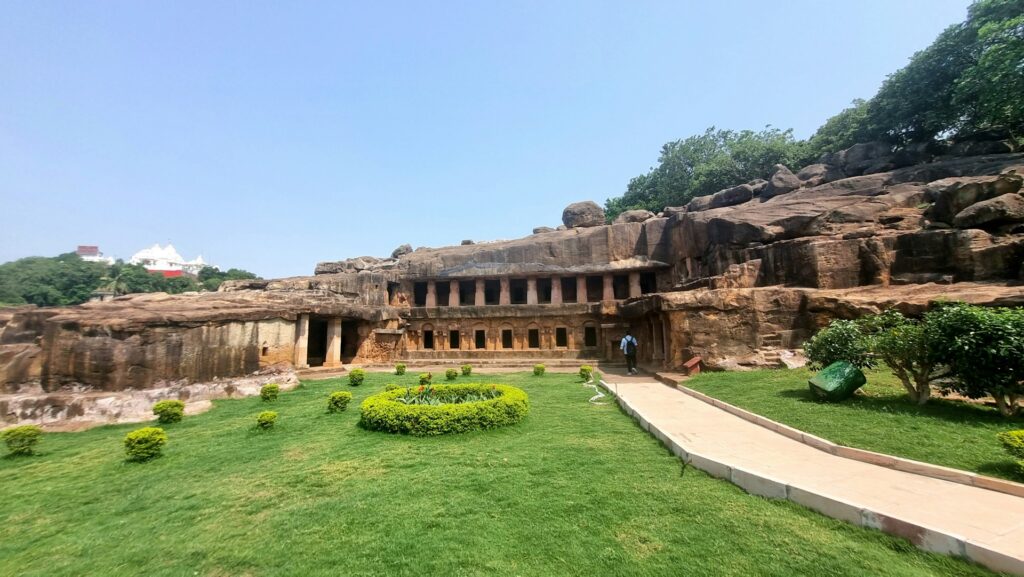Table of Contents
Introduction to Udayagiri and Khandagiri Caves
The Udayagiri and Khandagiri Caves are ancient rock-cut caves located in Odisha, India. These caves hold immense historical and archaeological significance, offering a glimpse into the rich cultural heritage of the region. Dating back to the 2nd century BCE, these caves are a testimony to the architectural prowess and artistic excellence of ancient Odisha.

» Historical Significance
These caves have been used by Jain monks as ancient residences, giving them great historical significance. It is thought that King Kharavela of the Mahameghavahana dynasty ordered the caverns. The names Udayagiri, which means “Sunrise Hill,” and Khandagiri, which means “Broken Hill,” were carefully carved to fit in with the austere Jaina principles. The site’s attraction is enhanced by its historical context, drawing in both historians and archaeologists.
Location and Layout of the Udayagiri Khandagiri Caves
Situated in the capital city of Bhubaneswar, Udayagiri and Khandagiri Caves are nestled atop twin hills known as Udayagiri (Hill of Sunrise) and Khandagiri (Broken Hill). The caves are carved out of natural sandstone and stand as a marvel of ancient engineering.
» Architecture and Artwork
These caves are breathtaking in their architectural magnificence. Khandagiri has 15 caves, compared to Udayagiri’s 18. Every cave is different from the others, with elaborate carvings and inscriptions that showcase the era’s artistic talent. The caves display elaborate sculptures, friezes, and motifs in a variety of architectural styles. Scenes from daily life, religious rituals, and regal processions are shown in the artwork within. A combination of Buddhist, Hindu, and Jain influences may be seen in the architectural features.
Description of Important Udayagiri Khandagiri Caves
- Cave 1: Rani Gumpha
Rani Gumpha, or the Queen’s Cave, is one of the largest caves with elaborately carved doorways and facades. The cave walls feature ornate carvings illustrating the life and exploits of King Kharavela.
- Cave 2: Hathi Gumpha
Hathi Gumpha, or Elephant Cave, is renowned for its Hathigumpha Inscription, which narrates the military exploits and triumphs of King Kharavela. The cave also features stunning sculptures of elephants.
- Cave 3: Ananta Gumpha
Ananta Gumpha, or the Snake Cave, houses intricate carvings of serpents and divine figures. The cave is adorned with inscriptions and artwork depicting religious ceremonies and rituals.
The Rich Cultural Heritage of Bhubaneswar
Odisha’s capital city, Bhubaneswar, is frequently referred to as the “Temple City of India.” The Udayagiri and Khandagiri Caves are intricately linked to its cultural legacy. The city is home to several historic temples, each with a unique tale to tell. When combined with these temples, the caverns provide a comprehensive view of the historical and cultural landscape of Bhubaneswar.
» Inscriptions and Scripts
These caves’ artwork and inscriptions provide us with important new perspectives on the social and religious customs of the era. King Kharavela’s life and accomplishments are chronicled in the Hathigumpha inscription, a noteworthy epigraph in Udayagiri. Not only do these inscriptions document history, but they also function as literary masterpieces that demonstrate the advanced language skills of ancient India.
Ancient scripts in Brahmi and Kalinga adorn the caverns, offering important clues about the language and script of prehistoric Odisha. These inscriptions describe the sociopolitical climate of that era as well as the reign of King Kharavela.
» Religious Significance
The Udayagiri and Khandagiri Caves have great religious importance for Jain devotees. There there was a Jain monastery at the middle of these caves. Many Jain devotees visit them to pay their respects and get spiritual comfort since they are revered. The serenity and peace of the caverns offer a calm setting for introspection and meditation.
Life in Ancient Odisha
The Udayagiri and Khandagiri Caves offer a window into the daily life and customs of ancient Odisha. The caves served as retreats for ascetics and contemplative spaces for spiritual seekers.

Udayagiri and Khandagiri Caves: A Tourist’s Delight
The caves are a major tourist attraction, drawing visitors from around the globe. Their historical importance, combined with the breathtaking views they offer, makes them a must-visit destination. The panoramic view from the hilltops, especially during sunrise and sunset, is a sight to behold. Tourists can also explore the surrounding areas, rich with flora and fauna, adding to the overall experience.
Best Time to Visit Udayagiri and Khandagiri Caves
The best time to visit these caves is during the winter months, from October to March. The weather during this period is pleasant, making it ideal for exploring the caves and the surrounding areas. The summer months can be quite hot, while the monsoon season brings heavy rains, which might hinder the exploration.
Tourism and Visitor Information of Udayagiri Khandagiri Caves
Today, the caves attract tourists and history enthusiasts from around the world. Visitors can explore the caves’ labyrinthine passages, marvel at the ancient rock-cut architecture, and immerse themselves in Odisha’s rich heritage.
» Preservation Efforts
The Udayagiri and Khandagiri Caves provide a number of preservation issues. The integrity of these ancient buildings is threatened by environmental conditions, human meddling, and natural erosion. Numerous conservation initiatives are under progress, led by the Archaeological Survey of India (ASI) and regional administrations. Through these efforts, the historical significance of the place will be preserved and future generations will be able to explore it.
» Comparative Analysis with Other Caves
The Udayagiri and Khandagiri Caves are often compared with other rock-cut cave complexes in India, such as Ajanta and Ellora Caves. Each site offers unique insights into India’s diverse architectural and artistic traditions.
» Famous Legends and Myths
Legend has it that the caves were carved out by virtuous Jain monks who sought solitude and enlightenment. These caves have also inspired numerous tales and folklore passed down through generations.
» Cultural Impact
The Udayagiri Khandagiri Caves remain a symbol of Odisha’s cultural pride and historical legacy. They continue to inspire artists, scholars, and historians, fostering a deeper appreciation for India’s ancient past.
Conclusion
Beyond just being historical locations, the Udayagiri and Khandagiri Caves provide a window into the past and provide insights into the social, cultural, and religious life of ancient India. Their beautiful sculptures, historical inscriptions, and tranquil setting make them a singular location that enhances Bhubaneswar’s cultural fabric. A trip to these caverns is an experience that links us to India’s rich spiritual and cultural legacy in addition to being a historical voyage.
-
Are Udayagiri Khandagiri Caves open to the public?
Yes, the caves are open to the public and accessible year-round.
-
How old are the Udayagiri Khandagiri Caves?
The caves date back to the 2nd century BCE, during the reign of King Kharavela.
-
What is the significance of the Hathigumpha Inscription?
The Hathigumpha Inscription narrates King Kharavela’s military exploits and achievements.
-
Are there guided tours available at the caves?
Yes, guided tours are available for visitors interested in learning more about the caves’ history and significance.
-
How can one reach Udayagiri Khandagiri Caves from Bhubaneswar?
The caves are located approximately 2-3 kilometers from the main bus stand of Bhubaneswar and can be easily reached by road.




Thank you for the valuable content. 🙂